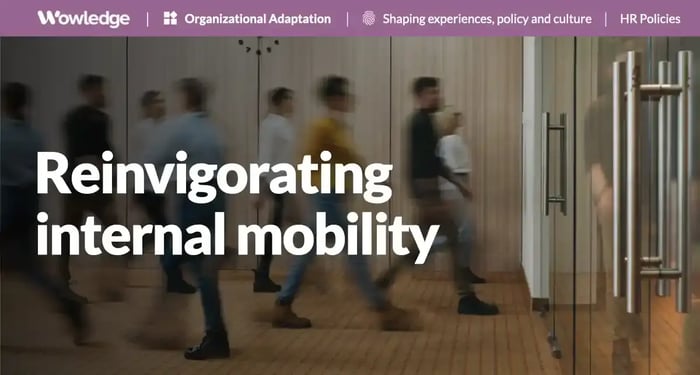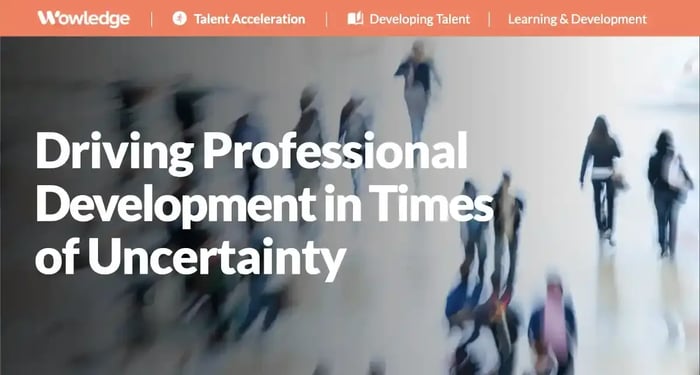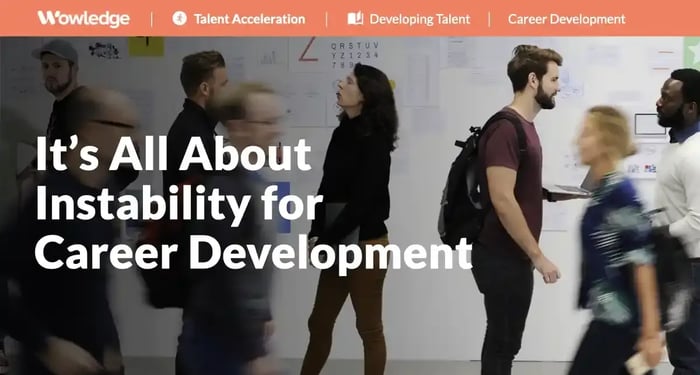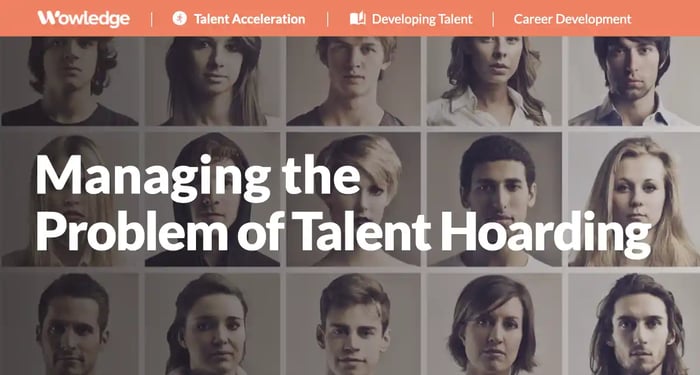Table of Contents
- The issues around lack of internal mobility are clear
- The advantages of enabling mobility are equally clear
- Why do companies resist employee mobility?
- Enhanced development for employees
- Actions to take to promote internal mobility
- 1. Update managerial mindsets and behaviors with policy alterations
- 2. Create change management strategies
- 3. Leverage mobility technologies
- 4. Measure and create accountabilities
- 5. Enable recruiters
- 6. Engage a broader view of models for mobility
- 7. Integrate mobility with other talent practices
- 8. Use data from the talent marketplace to identify skills gaps
- Relevant Practices & Tools
- FAQs
Retaining employees in today’s tight labor markets is as core to maintaining operational capabilities as many other talent outcomes, particularly with those in business-critical roles or functions. The risk of losing employees who are delivering the most value to an organization’s products and services is especially high right now, with the combination of high employment, talent shortages in many fields, employee (and candidate) expectations for flexible workplace options, etc. Internal mobility is a well-established yet vastly underutilized answer to the dilemma.
Internal mobility and advancement have long been identified as key drivers of retention, yet companies continue to struggle to provide and support such moves at scale. In fact, research reported in MIT’s Sloan Review showed that as few as 10% of job opportunities today are filled with internal lateral hires. The calls for enhanced employee movement for development purposes have been out there for years, and it offers a clear opportunity to address the current crisis with employee turnover and dissatisfaction.
The issues around lack of internal mobility are clear
According to research by the Pew Research Center, 63% of U.S. employees who quit their jobs in recent years cited a lack of career advancement opportunities as a leading reason for leaving. Furthermore (and distressingly so) it observed that the median lateral mobility rate for large U.S. companies is only 8% and only about a quarter of companies in the data set boasted rates above 15%.
Randstad research found similar perceptions among employees it surveyed, revealing that:
- 58% of workers agree their companies don’t currently have enough growth opportunities for them to stay long-term.
- 69% would be more satisfied if their employers better utilized their skills and abilities.
- 57% say they need to leave their current companies in order to take their careers to the next level.
In fact, in one of its Global Human Capital Trends surveys, Deloitte found that more than 50% of companies reported the oft-stated observation that it was easier for employees to find a job outside their organization than inside. It further reported that 76% of C-suite executives rated internal mobility as important, with 20% ranking it as one of their organization’s three most urgent issues.
With an apparently high awareness of leaders and such consistent messaging from employees about the primary reasons for leaving include low mobility and the need to quit to get a promotion or transfer, one would think that companies would get the message. And the data in support of enhanced mobility makes an even stronger case.
The advantages of enabling mobility are equally clear
LinkedIn reports that companies with high mobility enjoy almost 2 times the median employee tenure rates (5.4 years vs. 2.9 years). It also found that employees stay 41% longer at organizations with high internal hiring vs. those companies with much lower levels of such practices.
Recent studies by researchers at the Massachusetts Institute of Technology and New York University have found that lateral career opportunities are more than twice (2X) as effective as compensation in predicting employee retention, while i4cp’s data suggests that high-performing companies are twice (2X) as likely to emphasize talent mobility versus low-performing peers.
Oracle reports that the top 10% of companies with “high-performance work systems” filled over 60% of their jobs from within. Successful talent mobility programs yield substantial enterprise-wide benefits, including:
- Greater employee engagement
- Streamlined information flow
- Limited competitive-intelligence leakage
- Stronger leadership teams
- Better financial performance
Other benefits include:
- Enhanced retention: Deloitte reports that internal mobility boosts employee engagement by as much as 30%. In addition, research published in the MIT Sloan Review found that lateral career opportunities are more than twice (2X) as important as compensation in predicting employee retention.
- Better performance: Workers promoted into jobs have significantly better performance for the first two years than workers hired into similar jobs and lower rates of voluntary and involuntary exit.
- Accelerated time to competence: Existing employees need less time to adapt to a new job due to the fact that they have already learned and integrated the company culture, values, and lexicon into their thinking and performance. They may well also already have completed company-provided training that new hires would need to take.
- Lower costs with faster time-to-fill rates: employee replacement costs for new hires (e.g., higher increases, sign-on bonuses, relocation costs) are significant, and the time to fill jobs routinely exceed 30-45 days. Less time is needed for screening and interviewing internal candidates, and decision-making tends to be quicker due to the ready access to past performance evaluations and supervisory feedback.
- Building a leadership pipeline: Build leadership capability and increased bench strength by rotating employees through different functions, businesses, and locations in a way that creates a better-rounded and business-savvy employee base.
- Enhanced knowledge sharing: Employees crossing functional and business lines and naturally share best practices, knowledge, and skills with their new teams. This can create an ecosystem with more cross-functional collaboration and innovation, not to mention more diversity in thinking, problem-solving, and staffing.
- Enhanced work effort: According to Gartner for organizations with greater internal mobility, employees are 27% more likely to go the extra mile at work.
- Unbiased access to job opportunities: Corporate-level career mobility processes and programs create a transparency to opportunities that benefit those with the proper skills and motivation to learn and grow, regardless of demographic traits.

Why do companies resist employee mobility?
As internal mobility is not traditionally a typical or named function (on its own or as a sub-function staffed by HR professional(s), many companies rely solely upon policy manuals to enable and drive the process. Larger, more advanced organizations have however created functions with teams who create and oversee programs and processes covering such movement, but a recent search for jobs related to employee mobility are limited to few. However, as we’ll discuss later, there are technologies (e.g., talent marketplaces) that enable matching employees with opportunities. That said, resistance is still the primary driver of lower transfer rates in companies. The key drivers of that include:
Lack of awareness
Oftentimes, companies don’t collect quality reasons for leaving (RFL) data that yields reliable and truthful insights. The true reasons why employees quit are notoriously underreported for a series of theorized reasons—they don’t want to “burn bridges”, they can’t state that as a primary rationale (i.e., it is one of several reasons), or they feel that it is their business, not the company’s. Whatever the reason, exit interview data has long been suspect, with response choices such as “better opportunity” listed as the primary reason on interview/survey data.
Fear of losing key talent
Companies and managers may worry that allowing employees to move around too much will lead to a loss of critical talent, leading to both overly restrictive policies and “talent hoarding” by managers. They may also fear that employees will leave the company after gaining new skills and experiences.
Cost and disruption
Employee movement can be costly and disruptive, especially if it involves relocating employees to different locations or departments. At the department level it means a loss of productivity and wait for suitable replacements to not only be recruited, but also to be onboarded, brought up to speed, and aligned with the company culture and values.
No available opportunities
Companies may not have enough available opportunities for employees to move around. This can be particularly true in smaller organizations or in industries with limited job growth or specialization.
Siloed organizational structure
Companies with a siloed organizational structure may not encourage or facilitate employee movement. In such organizations where employees have long tenures, it may become a standard and badge of honor. Employees may also be pigeonholed into specific roles or departments, which can limit their exposure to other parts of the company.
Risk of knowledge loss
Companies may worry that allowing employees to move around too much will lead to a loss of institutional or process knowledge. Employees who move around may not have the same level of expertise or experience as those who have been in the same role or department for a longer period of time, running the additional risk of lowered productivity.
Needless to say, there are cultural issues that require addressing, and in this day and age, internal talent movement is a key development opportunity that needs to be addressed as part of the larger talent management strategy.
Enhanced development for employees
The movement of employees within an organization is a well-established and highly effective, but often overlooked form of learning and development, that as we have seen, offers many side benefits. The key ways in which that development experience is enhanced include:
- Exposure to new roles and responsibilities: When employees move within an organization, they are exposed to new roles and responsibilities, business challenges and environments. This allows them to expand their skillset, knowledge, and experience base, and can broaden their perspectives on the company mission and value proposition in different markets, customer sets, and types of operations.
- Cross-functional collaboration: Talent mobility can encourage collaboration across different functions and departments within an organization. With employees moving between functions, business units, and departments, it facilitates the sharing of ideas and knowledge, which can lead to new insights and learning opportunities.
- Feedback and coaching: As employees move into new roles, they are often provided with new feedback and coaching to help them succeed. This can help employees identify areas for improvement and develop new skills.
- Career path development: Talent mobility can provide employees with a clearer understanding of potential career paths within the organization. This can help them identify areas where they may have more passion and skill/aspiration matches or need additional training or experience to advance their careers.
- Exposure to different company sub-cultures: Moving within an organization can expose employees to different company cultures. This can help employees develop a better understanding of the organization as a whole and can enhance their ability to work with diverse teams.
Such movement helps employees grow, develop, and achieve their career goals, while also benefiting the organization by fostering a more engaged and skilled workforce.
Actions to take to promote internal mobility
So, what steps should a company take to build and enhance its career mobility practices and processes? Looking around the Human Resources (HR) and Talent Management functions, there are places to insert practices and tools while changing managerial biases and company culture around talent mobility.
1. Update managerial mindsets and behaviors with policy alterations
De-claw policies that require employees to get their manager’s approval to apply for a new role to incentivize career development. Having standards that require employees to stay in a new role for one year and be in good performance standing help stabilize work teams and their productivity, but after that, longer timeframes can become a burden and unnecessarily hold people back.
2. Create change management strategies
Extensive use of change management strategies such as structured communications, training, manager town halls, FAQs, surveys, and the like can be effective in changing managers’ perspectives not only on the value of updated policies and standards for the company but also for employees and themselves.
3. Leverage mobility technologies
Talent Marketplace systems use artificial intelligence (AI) to match employee data to job requirements. Many of these systems recognize gaps between current skillsets, experiences, and desired roles and make recommendations for future jobs and associated development and career paths. Use these systems to provide transparency and access to new job or project opportunities for all employees.
4. Measure and create accountabilities
Create metrics that monitor which business units, functions, departments and managers are talent exporters and which are talent importers. Make these metrics part of each manager’s and leader’s performance goals and standards.
5. Enable recruiters
Allow talent acquisition team members to access and contact current employees who meet the minimum standard to identify those who might be a good match for another opportunity.
6. Engage a broader view of models for mobility
Communicate and encourage managers to provide access not only to new jobs but also to experiential development opportunities, such as project or internal gig work, in which employees contribute to a project while remaining in their jobs. Implement some form of project matching using both succession planning outcomes and talent marketplace technologies to locate suitable employees. Short-term assignments, job sharing, and job shadowing can also be reasonable options.
7. Integrate mobility with other talent practices
Link mobility (job and project) to performance management, learning and development planning, and onboarding processes. Use employee skills data and volumes to inform the workforce planning process, to establish a mobility planning mindset and analysis. Create development plans (IDPs) that envision learning programs and experiences that will fill gaps in skills needed for both the current and future roles within and outside the department.
8. Use data from the talent marketplace to identify skills gaps
Leverage such hard data to inform the expansion or creation of learning and development programs to help close gaps and create communications to promote those specifically to people with some of the skills already in place.
Finally, and perhaps most importantly, consider employees as corporate-wide resources with top leadership support for mobility as a corporate capability-building machine. Helping to create a culture around continuous development, where employees are learning and applying new skills as part of their overall employment experience is a core outcome of establishing a formal mobility program and process.
Relevant Practices & Tools
Core Career Development Practices that Translate Employee Ambitions into Occupational Progression Action Plans. >
Core Career Development is a process through which employee development is guided towards a targeted series of successive job roles that build upon one another and provide... more »
Creating a Culture of Internal Mobility that Supports Employee Development and Retention. >
Creating a culture of mobility requires management to accept that the benefits of movement (promotions and transfers) far outweigh the costs of replacing workers in their teams... more »
Defining Career Lattices to Define Robust Lateral and Vertical Mobility. >
The ability to enable the movement of employees proactively and strategically from role to role at the leadership, professional, and operational levels is a key flexibility... more »
Auto-generating Career Opportunities by an AI Technology-driven Talent Marketplace. >
Talent or Opportunity Marketplace systems are Artificial Intelligence (AI)-enabled software that have varying capabilities, but primarily match employee data to job requirements... more »
The Success Profile Tool: Specify the Background, Skills, and Capabilities Expected from Individuals in Key Roles. >
A template resembling a job description further detailed with the competencies and useful experiences that separate minimum job requirements from the attributes... more »
FAQs
What simple policy changes unlock more internal moves quickly?
Drop “manager approval to apply,” set a clear minimum time-in-role (often 12 months), and require good standing (e.g., no documented performance or conduct issues), and then let employees apply to jobs for which they are qualified. Publish fair posting windows (e.g., 2 weeks) and target start dates to make moves more predictable. Engage top leaders to champion and promote movement as a cross-organizational benefit. Use talent reviews to identify replacement pools managers can tap for suitable replacements, helping supplant “talent hoarding” behaviors. Add a short backfill plan template so managers lose the fear of gaps, and the process keeps moving.
How do talent marketplaces help beyond job postings?
Talent marketplace technologies automatically match employee skills, interests, and availability to identify appropriate jobs, gigs, and projects, while surfacing gaps to be filled and offering learn-now paths to increase talent readiness. They widen access by showing staffing and replacement options across teams, not just in a home function. The data also feeds learning plans and workforce planning, so development spend matches real demand.
How can smaller companies build mobility without new technology investments?
Start with a single internal jobs page and a weekly talent call where leaders and managers share near-term needs and ready-to-move employee names (e.g., based on 2+ years in the same role with no clear path to advancement or a desire to move into career-changing, aspirational roles). Develop brief skill, proficiency, and experience profiles, and have each employee complete or update one annually to speed moves. Track transfer and promotional moves in a shared spreadsheet and celebrate wins through publicizing the moves to make mobility a cultural touchstone.
How should recruiters partner with HR and managers to boost internal hiring?
Give talent acquisition recruiters access to internal profiles and let them source inside first for a set window. Recruiters can run the same structured process used for externals, but with additional steps to clarify the employee’s eligibility for a move, their interest in being considered, and leadership support for participation in the selection process. They also coach internal candidates on gaps and next-best roles to keep momentum. Leadership support and approvals are essential to providing such access, and giving recruiters the ability to scan and select internal candidates









